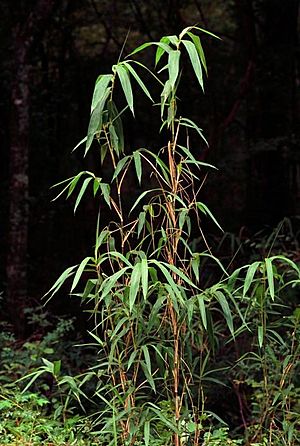Arundinaria gigantea facts for kids
Quick facts for kids Arundinaria gigantea |
|
|---|---|
 |
|
| Scientific classification | |
| Genus: |
Arundinaria
|
| Species: |
gigantea
|
Arundinaria gigantea is a type of bamboo often called giant cane or river cane. It grows naturally only in the south-central and southeastern parts of the United States. You can find it as far west as Oklahoma and Texas, and as far north as New York.
This plant has two main types, called subspecies. One subspecies, tecta, is sometimes known as Arundinaria tecta or switch cane. It looks a lot like the main giant cane but is usually smaller. Switch cane also prefers to grow in wetter places.
Giant cane and other Arundinaria species can grow in huge groups. These groups are called canebrakes. Long ago, canebrakes were very common in the southeastern United States. Today, however, this special ecosystem is in danger.
Contents
What is Giant Cane?
This bamboo is a type of cane. It is a grass that lives for many years. It has a round, hollow stem that can be over 7 centimeters (about 3 inches) wide. These stems can grow as tall as 10 meters (about 33 feet)!
How it Grows
Giant cane grows from a large network of thick rhizomes. Rhizomes are like underground stems that spread out. Its leaves are shaped like spears and can be up to 30 centimeters (about 12 inches) long. They can also be up to 4 centimeters (about 1.5 inches) wide.
The plant's flowers grow in a cluster called an inflorescence. These flower clusters are usually 4 to 7 centimeters (about 1.5 to 3 inches) long. Each individual cane plant lives for about 10 years. Most new plants grow from the rhizomes, not from seeds. This is called vegetative reproduction. Giant cane rarely produces seeds and flowers only sometimes. Sometimes, many plants flower all at once.
Where Giant Cane Lives
Giant cane is a native plant that lives in many different plant groups. It often grows under taller trees or in the middle layer of a forest.
Its Home Environment
You can find it in pine forests with trees like loblolly and longleaf pine. It also grows among oaks, cypress, ash, and cottonwood trees. Other smaller plants that grow nearby include inkberry and wax myrtle.
Canebrake areas are found in many places. These include floodplains, bogs, woods near rivers, and savannas. Giant cane grows well in wet or flooded soils. It can also survive wildfires. In fact, canebrakes often stay healthy with regular fires.
Animals and the Canebrake
This cane is an important food source for the southern pearly eye butterfly. Canebrakes are also a key home for several birds. These include the Swainson's, hooded, and Kentucky warblers. The white-eyed vireo also uses this habitat. Sadly, the loss of canebrakes might have caused the extinction of the Bachman's warbler. This bird needed canebrakes for its nests.
Why Giant Cane is in Danger
Canebrakes started to disappear after Europeans settled in the American southeast. Many things caused this decline.
Threats to Canebrakes
One big problem was the introduction of livestock like cattle. Cows love to eat the leaves of the cane. At first, cane was seen as good food for animals. But soon, too much overgrazing started to destroy the canebrake habitat.
Other reasons for the decline include turning the land into farmland. Also, stopping natural fires, called fire suppression, hurt the canebrakes. These areas need fires to stay healthy.
How People Use Giant Cane
People have used giant cane for many things throughout history.
Traditional Uses
The Cherokee people, especially the Eastern Band of Cherokee Indians, use this plant for basketry. Historically, the Cherokee kept canebrakes healthy by cutting the cane and burning the areas regularly. This practice stopped when Europeans settled the land. The loss of cane habitat almost led to the loss of basket-making art. This art is very important for the Cherokee economy today.
Other Native American groups, like the Seminole and Choctaw, also used cane. They made medicine, blowguns, bows and arrows, knives, and spears from it. They also crafted flutes, candles, and even walls for their homes. Cane was used for fish traps, sleeping mats, and tobacco pipes.
See also
 In Spanish: Arundinaria gigantea para niños
In Spanish: Arundinaria gigantea para niños

